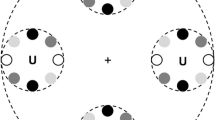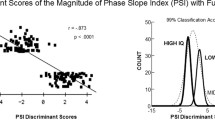Abstract
In normal development, midline crossing inhibition (MCI) generally disappears by age nine. Individuals with mental retardation exhibit developmental delays which are manifested as failure to attain motor milestones. This study utilized a new methodology predicated upon a response processing model to measure MCI in 20 adults with moderate mental retardation. A chronologically equivalent group of individuals with mental retardation served as the control group. Measurements of reaction time (RT) and movement time were recorded as a subject performed ipsilateral, midline and contra-lateral movements. The rationale behind this experiment was that crossing midline to the contralateral side constituted a more complex task, requiring more response processing time and longer RTs. Analysis of the RT revealed inhibitory responses in the subjects with mental retardation when movements were made in a contralateral direction with the preferred hand. No inhibition was manifested by the subjects in the control group. This new method of assessing MCI detected this phenomenon with subjects who were mentally retarded.
Similar content being viewed by others
References
Anson, J. G. (1982). Memory drum theory: Alternative tests and explanations for the complexity effects on simple reaction time.J. Motor Behav., 14: 228–246.
Arendt, R. E., MacLean, W. E., and Baumeister, A. A. (1988). Critique of sensory integration theory and its application in mental retardation.Am. J. Ment. Retard., 92: 401–411.
Auxter, P., and Pyfer, J. (1985)Adapted Physical Education and Recreation, Times Mirror/Mosby, St. Louis, MO.
Ayres, A. J. (1972).Southern California Sensory Integration Tests, Western Psychological Services, Los Angeles, CA.
Baumeister, A., Wilcox, S., and Greeson, J. (1969) Reaction time of retardates and normals as a function of relative stimulus frequency.Am. J. Ment. Def. 73: 935–941.
Beck, R. J., Andriacchi, T. P., Kuo, K. N., Fermier, R. W., and Galante, J. O. (1983). Changes in the gait patterns of growing children.J. Bone Joint Surg. 63: 1452–1457.
Benton, A. (1955). Right left discrimination and finger localization in defective children.Arch. Neurol. Psychiatry, 74: 583–589.
Brewer, N., and Nettelbeck, T. (1977). Influence of contextual cues on the choice reaction time of midly retarded adults.Am. J. Ment. Def., 82: 37–43.
Brunt, D., Housner, L., and McElroy, J. (1983). The manipulation of dominant/non-dominant hand and ipsilateral/contralateral movement as a function of response organization in fourth grade children.Percept. Motor Skills, 56: 331–334.
Connolly, B. H., and Michael, B. T. (1986). Performance of retarded children, with and with without Down Syndrome, on the Bruininks Oseretsky test of motor proficiency.Phys. Ther., 66: 344–348.
Davis, W.E., Sparrow, W. A., and Ward, T. (1991). Fractionated reaction times and movement times of Down Syndrome and other adults with mental retardation.Adapt. Phys. Act. Quart., 8: 221–233.
Deutsch, H., Kilani, H., Moustafa, E., Hamilton, N., and Herbert, J. P. (1987). Effect of head-neck position on elbow flexor muscle torque production.Phys. Ther., 67: 517–521.
Distefano, E. A., and Brunt, D. (1982). Mentally retarded and normal children's performance on gross motor reaction—and movement—time tasks with varying degrees of uncertainty of movement.Percept. Motor Skills, 55: 1235–1236.
Eason, R. L., Brandon, J. E., Smith, T. L., and Serpas, D. C. (1986). Relaxation training effects on reaction/response time, frontalis EMG and behavioral measures of relaxation with hyperactive males.Adapt. Phys. Act. Quart., 3: 329–341.
Eason, R. L., and Surburg, P. R. (1990, June).Effects of midline crossing on reaction and response time of mentally retarded subjects, Paper presented at the annual conference of the North American Society for the Psycholog of Sport and Physical Activity. Houston, TX.
Fairweather, H., and Hutt, S. J. (1978). On the rate of gain of information in children.J. Exp. Child Psychol. 26: 216–229.
Fiorentino, M. R. (1973).Reflex Testing Methods for Evaluating CNS Development (Second edition), Charles C Thomas, Springfield, IL.
Gosling, H., and Jenness, D. (1974). Temporal variables in simple reaction times of mentally retarded boys.Am. J. Ment. Def., 79: 214–224.
Hawkins, W. F., Baumeister, A. A., and Holland, J. M. (1965). Reaction time in retardates following variation in warning signal intensity and preparatory interval.Am. J. Ment. Def. 70: 135–138.
Henry F. (1961). Reaction time—movement time correlation.Percep. Motor Skills 41: 63–66.
Henry, F. M., and Rodgers, D. E. (1960). Increased response latency for complicated movements and a “memory drum” theory of neuromotor reactions.Res. Quart. 31: 448–458.
Hodgkins, J. (1963). Reaction time and speed of movement in males and females of various ages.Res. Quart. 34: 335–343.
Hoover, J. H., Wade, M. G., and Newell, K. M. (1981). Training moderately and severely mentally retarded adults to improve reaction and movement times.Am. J. Ment. Def. 85: 389–395.
Joubert, C. E., and Baumeister, A. A. (1970). Effects of varying the length and frequency of response—stimulus interval on reaction times of normals and mentally deficient subjects.J. Comp. Physiol. Psychol. 73: 105–110.
Klapp, S. T., Wyatt, E. P., and MacLingo, W. (1974). Response programming in simple and choice reactions.J. Motor Behav. 6: 263–271.
Krupski, A. (1977). Role of attention in the reaction—time performance of mentally retarded adolescents,Am. J. Ment. Def. 82: 79–83.
Maloney, M., Ball, T., and Edgar, C. L. (1970). Analysis of the generalizability of sensory—motor training,Am. J. Ment. Def., 74: 458–469.
Mulhern, T., and Baumeister, A. A. (1971). Effects of stimulus—response compatibility and complexity upon reaction times of normals and retardates.J. Comp. Physiol. Psychol. 75: 459–463.
Porretta, D. (1987). Selected parameters of response organization in mildly mentally retarded children.Percept. Motor Skills 64: 95–100.
Reilly, M. A., and Spirduso, W. W. (1991). Age-related differences in response programming.Res. Quart. Exercise Sport 62: 178–186.
Robertson, M. A. (1984). Changing motor patterns during childhood. In Thomas, J. R. (ed.),Motor Development During Childhood and Adolescence, Burgess, Minneapolis, pp. 48–86.
Schmidt, R. A. (1988).Motor Control and Learning: A Behavioral Emphasis (second edition), Human Kinetics, Champaign, IL.
Schofield, W. (1976). Do children find movements which cross the midline difficult?Quart. J. Exp. Psychol. 28: 571–582.
Surburg, P. R. (1991). Preparation process facilitation of a motor task through imagery practice with adolescents who have mental retardation.Am. J. Ment. Retard. 95: 428–434.
Thomas, J. R. (1980). Acquisition of motor skills: Information processing differences between children and adults.Res. Quart. Exercise Sport 51: 158–173.
Wade, M. G., Newell, K. M., and Wallace, S. A. (1978). Decision time and movement time as a function of response time complexity in retarded persons,Am. J. Ment. Def. 83: 135–144.
Wapner, S., and Cirillo, L. (1968). Imitation of a model's hand movements: Age changes in transposition of left—right relations.Child Develop. 39: 887–894.
Zelaznik, H. N., and Aufderheide, S. K. (1986). Attentional and reaction time analysis of performance: Implications for research with mentally handicapped individuals. In Wade M. G. (ed.),Motor-Skill Acquisition of the Mentally Handicapped: Issues in Research and Training, Amsterdam, North Holland, pp. 131–153.
Author information
Authors and Affiliations
Rights and permissions
About this article
Cite this article
Surburg, P.R., Johnston, J. & Eason, B.L. Effects of midline crossing on response processing of adults with mental retardation. J Dev Phys Disabil 6, 327–338 (1994). https://doi.org/10.1007/BF02578419
Issue Date:
DOI: https://doi.org/10.1007/BF02578419




